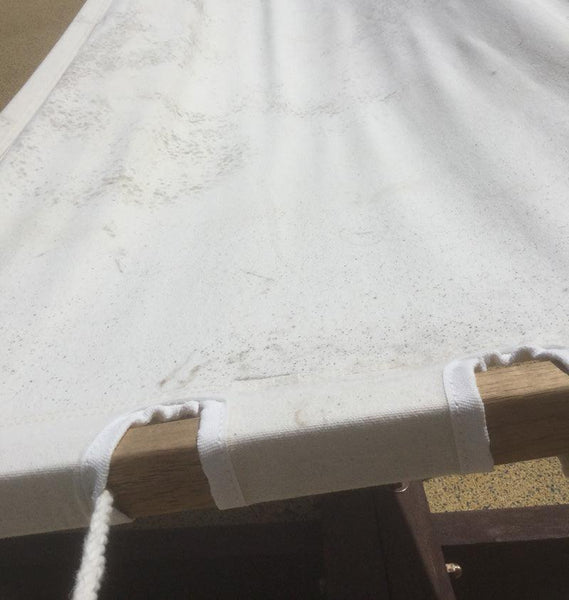Hammocks and mild-ewwww! (Mildew)

If you have garden furniture then you’ve likely experienced mildew. Unless you live in a box where the temperature is controlled or you didn’t know it was mildew in the first place.
For the mildew virgins out there…
Mildew is a form of fungus. Its twin is mold which appears in various colors, whilst mildew is relatively white. Mildew is formed when the food source and moisture are present with a relative humidity of between 62-93% and temperature of 25-31°C. With that trifecta your yummy cotton hammock has no chance. Or does it?
How can you get rid of mildew?
If your hammock has mildew it’s best to get started with a good clean. Word to the wise - this is where the periodic inspection is needed if you have a hammock that’s been stored in the garage for a while. Aside from bugs or ticks picking it as a prime spot, mold and mildew are likewise good contenders.
No strong chemicals are needed to clean mildew, you just need a bucket of warm, soapy water and a soft bristled brush with a bit of good old elbow grease.
If your hammock has a spreader bar, take it down and place it on a flat surface and start scrubbing. Scrub with mild force, not too heavy-handed to destroy your hammock but not too soft either. Do the same for both sides and once done, wash it all off and let it air dry. Place it where there is ample sunlight as you need to make sure that all moisture has gone (especially around the wooden bars) otherwise you have got yourself a new mildew factory. Yay!
Hammocks without spreader bars are easier and most can be put in the washing machine just remember to read the care label first. If your hammock needs extra care you can hand wash it or use a washing bag/sock to put the hammock inside. Again, let it dry properly before storing away.
5 quick steps to remove mildew:
1. In well ventilated area brush away mildew with soft brush.
2. Apply white vinegar to stains and leave it for 30 minutes in the sun.
3. After 30 minutes brush and rinse with cold water.
4. For stubborn stains use baking soda or oxygen bleach.
5. Remember to read the care label of your hammock.
My hammock already has mildew!
If you find your hammock in a garish state with mildew stains then it’s best not to wet the hammock at first. Take your hammock outside and start brushing away the particles from the mildew stains using a soft brush. Do not breathe in the dust and we recommend wearing a mask. Treat both sides with this process.
Once done, apply white vinegar onto the stained spots of your hammock, let it sit for at least 30 minutes under the sun. Then using a soft brush scrub the stains and occasionally rinse your brush with cold water to remove any spurs. For stubborn stains try the same process with baking soda.
 By this time most stubborn stains should be out. Get warm soapy water and start scrubbing, rinse and hang to dry. If for some reason you can still see mildew stains then it’s time to bring the big guns out and mix oxygen bleach with water. Remember, you are trying to get rid of the mildew not your hammock. So go easy on the bleach. When in doubt, it’s best to consult your hammock’s care instruction beforehand.
By this time most stubborn stains should be out. Get warm soapy water and start scrubbing, rinse and hang to dry. If for some reason you can still see mildew stains then it’s time to bring the big guns out and mix oxygen bleach with water. Remember, you are trying to get rid of the mildew not your hammock. So go easy on the bleach. When in doubt, it’s best to consult your hammock’s care instruction beforehand.
Prevention is better than mildew…
Simply put, periodically cleaning and examining your hammock will be your best bet to prevent mildew growth.
Look at our weatherproof hammocks which are less likely to get mildew and our Hammock Carekit.